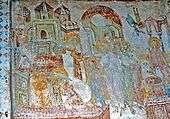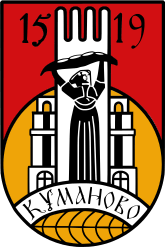Matejče Monastery
The Monastery of the Most Holy Mother of God (Serbian: Манастир Пресвете Богородице), commonly known as Matejče (Матејче) or Matejić (Матејић), is a 14th-century Serbian Orthodox monastery located in the village of Matejče on the slopes of Skopska Crna Gora, near Skopje and Kumanovo. The village is inhabited by 89% Muslim Albanians and 10% Orthodox Serbs (2002 census).
| Monastery information | |
|---|---|
| Full name | Monastery of the Most Holy Mother of God |
| Other names | Matejić |
| Order | Serbian Orthodox |
| Established | 1357 |
| Dedicated to | Ascension of Holy Mother |
| Controlled churches | Church of Ascension of Holy Mother |
| People | |
| Founder(s) | Stefan Uroš V |
| Site | |
| Location | Matejče, Lipkovo Municipality, North Macedonia |
| Public access | yes |
The monastery was built in the 14th century on the ruins of an older, Byzantine Greek church built in 1057–59, evident in preserved Greek inscriptions.[1][2] It was mentioned for the first time in 1300 in a chrysobull of Serbian king Stefan Milutin (r. 1282–1321). In the mid-14th century, Serbian emperor Stefan Dušan (r. 1331–55) started reconstructing the monastery, finished by his son Stefan Uroš V in 1357 (becoming his endowment). Coins of Uros V has been found at the site.[3] Isaiah the Serb and Vladislav Gramatik lived in the monastery. In the 18th century the roof was removed by the Ottomans and put on the Eski Mosque in Kumanovo, after which it deteriorated. In 1926–34 the monastery was renovated.
It is designed in the cross-in-square plan (as is also Marko's Monastery and the Banja Monastery).[4] The dome bears the same exonarthex technique as Hilandar.[5] It was painted in 1356–57.[6]
The monastery was occupied by Albanian insurgents and used as a base during the Insurgency in the Republic of Macedonia (2001).[7][8] Serbian Patriarch Pavle issued a statement to the UN regarding the destruction of Serbian monasteries in Kosovo, and the threat of destruction of monasteries in Macedonia.[9] The church exterior was not damaged, however, the interior and inventory were stolen or burnt.[9] The region saw emigration of Serbs during the conflict.
Gallery
| Wikimedia Commons has media related to Matejić Monastery. |
 Desecrated fresco
Desecrated fresco Desecrated fresco
Desecrated fresco Christ talking to Women of Jerusalem
Christ talking to Women of Jerusalem Praying Before the Rods of the Suitors, Virgin Entrusted to Joseph, Annunciation of the Virgin
Praying Before the Rods of the Suitors, Virgin Entrusted to Joseph, Annunciation of the Virgin Preparing of the Cross
Preparing of the Cross Sts. Peter and Paul Preaching in Rome
Sts. Peter and Paul Preaching in Rome The Crucifixion
The Crucifixion The Cycle of the Acts of the Apostles - St. Peter Preaching in Jerusalem
The Cycle of the Acts of the Apostles - St. Peter Preaching in Jerusalem The Cycle of the Ecumenical Councils - Council of Tzar Stefan
The Cycle of the Ecumenical Councils - Council of Tzar Stefan V kontakion
V kontakion VI oikos
VI oikos
References
- "Radoslav M. Grujić : PRAVOSLAVNA SRPSKA CRKVA". Svetosavlje.org. Retrieved 2016-01-02.
- Marković 1920.
- "Novac Cara Stefana Urosa V Nejakog (1355-1371)" (PDF). Ubs-asb.com. Retrieved 2016-01-02.
- Abstracts of Papers. 1–9. Byzantine Studies Conference. 1975. p. 37.
- Воjислав Ђурић (1989). Dečani i vizantijska umetnost sredinom 14 veka: Medjunarodni naučni skup povodom 650 godina manastira Dečana septembar 1985. Primljeno na 9 skupu Odeljenja istorijskich nauka, održanom 25. novembra 1987 ; Ured. Vojislav J. Djuric. Српска академиj наука и уметности.
- Richard Hamann-Mac Lean; Horst Hallensleben (1976). Die Monumentalmalerei in Serbien und Makedonien: Grundlegung zu einer Geschichte der mittelalterlichen Monumentalmalerei in Serbien und Makedonien. W. Schmitz. p. 34.
- "ISTORIJSKA SANSA DA SRBI I ALBANCI POSTIGNU SPORAZUM" (PDF). Rastko.rs. Retrieved 2016-01-02.
- "Vreme 540 - Eksplozija krize u Makedoniji: Rat i(li) mir". Vreme.com. Retrieved 2016-01-02.
- "NATO Secretary-General and responded to Patriarch Pavle : The village was demolished, and the Church intact in Matejevac". Arhiva.glas-javnosti.rs. Retrieved 2016-01-02.
Further reading
- Elizabeta Dimitrova (2002). Manastir Matejče. Centar za kulturno i duhovno nasledstvo Kalamus. OCLC 55758039.
- Vasilije Marković (1920). Pravoslavno monaštvo i manastiri u srednjevekovnoj Srbiji. Srpska Manasterska S̆tamparija.
